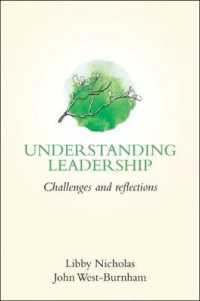- ホーム
- > 洋書
- > 英文書
- > Psychology
Full Description
Until recently there had been relatively little integration of programs of research on teaching, learning, curriculum, and assessment. However, in the last few years it has become increasingly apparent that a more unified program of research is needed to acquire an understanding of teaching and learning in schools that will inform curriculum development and assessment. The chapters in this volume represent a first step toward an integration of research paradigms in one clearly specified mathematical domain.
Integrating a number of different research perspectives is a complex task, and ways must be found to reduce the complexity without sacrificing the integration. The research discussed in this volume is tied together because it deals with a common content strand. During the last ten years specific content domains have served as focal points for research on the development of mathematical concepts in children. The areas of addition and subtraction, algebra, rational numbers, and geometry are notable examples. Whether a similar organizational structure will prevail for programs of research that integrate the study of teaching, learning, curriculum, and assessment is an open question. The perspectives presented in this volume illustrate the potential for adopting this perspective.
Contents
Contents: Part I:Overview.T.P. Carpenter, E. Fennema, T.A. Romberg, Toward A Unified Discipline of Scientific Inquiry. Part II:Content Analyses of Rational Numbers.M.J. Behr, G. Harel, T. Post, R. Lesh, Rational Numbers: Toward a Semantic Analysis -- Emphasis on the Operator Construct. T.E. Kieren, Rational and Fractional Numbers: From Quotient Fields to Recursive Understanding. Part III:Students' Thinking.N.K. Mack, Learning Rational Numbers With Understanding: The Case of Informal Knowledge. L.B. Resnick, J.A. Singer, Protoquantitative Origins of Ratio Reasoning. S.J. Lamon, Ratio and Proportion: Children's Cognitive and Metacognitive Processes. Part IV:Teachers and Teaching.D.L. Ball, Halves, Pieces, and Twoths: Constructing and Using Representational Contexts in Teaching Fractions. C.A. Brown, A Critical Analysis of Teaching Rational Number. J.A. Hiebert, Benefits and Costs of Research That Links Teaching and Learning Mathematics. J.T. Sowder, N. Bezuk, L.K. Sowder, Using Principles From Cognitive Psychology to Guide Rational Number Instruction for Prospective Teachers. Part V:Assessment.S.P. Marshall, Assessment of Rational Number Understanding: A Schema-Based Approach. Part VI:Curriculum and Instruction.L. Streefland, Fractions: A Realistic Approach. T.R. Post, K.A. Cramer, M. Behr, R. Lesh, G. Harel, Curriculum Implications of Research on the Learning, Teaching, and Assessing of Rational Number Concepts.








